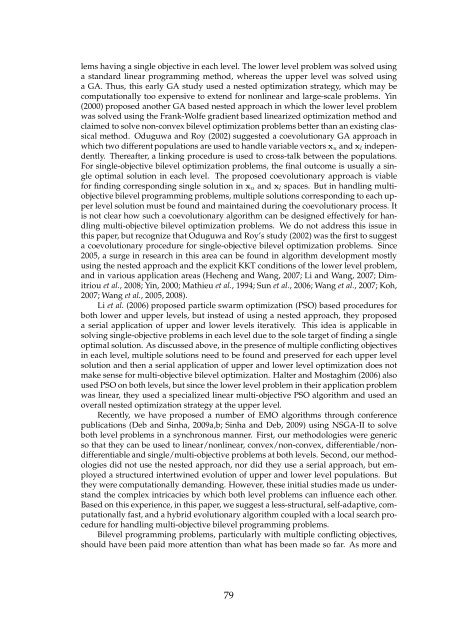Progressively Interactive Evolutionary Multi-Objective Optimization ...
Progressively Interactive Evolutionary Multi-Objective Optimization ...
Progressively Interactive Evolutionary Multi-Objective Optimization ...
You also want an ePaper? Increase the reach of your titles
YUMPU automatically turns print PDFs into web optimized ePapers that Google loves.
lems having asingle objective ineachlevel. Thelower levelproblemwas solvedusing<br />
a standard linear programming method, whereas the upper level was solved using<br />
a GA. Thus, this early GA study used a nested optimization strategy, which may be<br />
computationally too expensive to extend for nonlinear and large-scale problems. Yin<br />
(2000)proposed another GA based nested approach in which the lower level problem<br />
was solved using the Frank-Wolfe gradient based linearizedoptimization method and<br />
claimedtosolvenon-convexbileveloptimizationproblemsbetterthananexistingclassical<br />
method. Oduguwa and Roy (2002) suggested a coevolutionary GA approach in<br />
whichtwodifferentpopulationsareusedtohandlevariablevectors xu and xl independently.<br />
Thereafter, a linking procedure is used to cross-talk between the populations.<br />
For single-objective bilevel optimization problems, the final outcome is usually a single<br />
optimal solution in each level. The proposed coevolutionary approach is viable<br />
for finding corresponding single solution in xu and xl spaces. But in handling multiobjectivebilevelprogrammingproblems,multiplesolutionscorrespondingtoeachupperlevelsolution<br />
mustbefoundandmaintainedduring thecoevolutionary process. It<br />
is not clear how such a coevolutionary algorithm can be designed effectively for handling<br />
multi-objective bilevel optimization problems. We do not address this issue in<br />
thispaper,butrecognizethatOduguwaandRoy’s study(2002)wasthefirsttosuggest<br />
a coevolutionary procedure for single-objective bilevel optimization problems. Since<br />
2005, a surge in research in this area can be found in algorithm development mostly<br />
using the nested approachand the explicit KKT conditions of the lower level problem,<br />
and in various application areas (Hecheng and Wang, 2007; Li and Wang, 2007; Dimitriou<br />
et al., 2008;Yin, 2000;Mathieu et al., 1994;Sun et al., 2006;Wang et al., 2007;Koh,<br />
2007;Wang etal., 2005,2008).<br />
Li et al. (2006) proposed particle swarm optimization (PSO) based procedures for<br />
both lower and upper levels, but instead of using a nested approach, they proposed<br />
a serial application of upper and lower levels iteratively. This idea is applicable in<br />
solving single-objective problemsineachlevelduetothesoletargetoffinding asingle<br />
optimalsolution. Asdiscussedabove,inthepresenceofmultipleconflicting objectives<br />
in each level, multiple solutions need to be found and preserved for each upper level<br />
solution and then a serial application of upper and lower level optimization does not<br />
makesense formulti-objective bileveloptimization. HalterandMostaghim(2006)also<br />
usedPSOonbothlevels,butsincethelowerlevelproblemintheirapplicationproblem<br />
was linear, they used a specialized linear multi-objective PSO algorithm and used an<br />
overallnested optimization strategyatthe upperlevel.<br />
Recently, we have proposed a number of EMO algorithms through conference<br />
publications (Deb and Sinha, 2009a,b; Sinha and Deb, 2009) using NSGA-II to solve<br />
both level problems in a synchronous manner. First, our methodologies were generic<br />
so that they can be used to linear/nonlinear, convex/non-convex, differentiable/nondifferentiableandsingle/multi-objective<br />
problemsatbothlevels. Second,ourmethodologies<br />
did not use the nested approach, nor did they use a serial approach, but employed<br />
a structured intertwined evolution of upper and lower level populations. But<br />
they werecomputationally demanding. However,these initial studies madeus understand<br />
the complex intricacies by which both level problems can influence each other.<br />
Basedonthisexperience,inthispaper,wesuggestaless-structural,self-adaptive,computationallyfast,andahybridevolutionaryalgorithmcoupledwithalocalsearchprocedurefor<br />
handling multi-objective bilevelprogramming problems.<br />
Bilevel programming problems, particularly with multiple conflicting objectives,<br />
should have been paid more attention than what has been made so far. As more and<br />
79
















